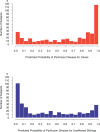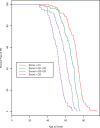A genomic pathway approach to a complex disease: axon guidance and Parkinson disease
- PMID: 17571925
- PMCID: PMC1904362
- DOI: 10.1371/journal.pgen.0030098
A genomic pathway approach to a complex disease: axon guidance and Parkinson disease
Abstract
While major inroads have been made in identifying the genetic causes of rare Mendelian disorders, little progress has been made in the discovery of common gene variations that predispose to complex diseases. The single gene variants that have been shown to associate reproducibly with complex diseases typically have small effect sizes or attributable risks. However, the joint actions of common gene variants within pathways may play a major role in predisposing to complex diseases (the paradigm of complex genetics). The goal of this study was to determine whether polymorphism in a candidate pathway (axon guidance) predisposed to a complex disease (Parkinson disease [PD]). We mined a whole-genome association dataset and identified single nucleotide polymorphisms (SNPs) that were within axon-guidance pathway genes. We then constructed models of axon-guidance pathway SNPs that predicted three outcomes: PD susceptibility (odds ratio = 90.8, p = 4.64 x 10(-38)), survival free of PD (hazards ratio = 19.0, p = 5.43 x 10(-48)), and PD age at onset (R(2) = 0.68, p = 1.68 x 10(-51)). By contrast, models constructed from thousands of random selections of genomic SNPs predicted the three PD outcomes poorly. Mining of a second whole-genome association dataset and mining of an expression profiling dataset also supported a role for many axon-guidance pathway genes in PD. These findings could have important implications regarding the pathogenesis of PD. This genomic pathway approach may also offer insights into other complex diseases such as Alzheimer disease, diabetes mellitus, nicotine and alcohol dependence, and several cancers.
Conflict of interest statement
Competing interests. TGL and DMM report a provisional application for patent under 37 CFR § 1.53 (c) entitled “Predicting Parkinson's Disease.” No monies have been awarded to date. JFM is employed by Gene Logic.
Figures




Similar articles
-
Beyond Parkinson disease: amyotrophic lateral sclerosis and the axon guidance pathway.PLoS One. 2008 Jan 16;3(1):e1449. doi: 10.1371/journal.pone.0001449. PLoS One. 2008. PMID: 18197259 Free PMC article.
-
Neither replication nor simulation supports a role for the axon guidance pathway in the genetics of Parkinson's disease.PLoS One. 2008 Jul 16;3(7):e2707. doi: 10.1371/journal.pone.0002707. PLoS One. 2008. PMID: 18628988 Free PMC article.
-
Axon guidance and synaptic maintenance: preclinical markers for neurodegenerative disease and therapeutics.Trends Neurosci. 2009 Mar;32(3):142-9. doi: 10.1016/j.tins.2008.11.006. Epub 2009 Jan 21. Trends Neurosci. 2009. PMID: 19162339 Free PMC article. Review.
-
SNPs in axon guidance pathway genes and susceptibility for Parkinson's disease in the Korean population.J Hum Genet. 2011 Feb;56(2):125-9. doi: 10.1038/jhg.2010.130. Epub 2010 Nov 18. J Hum Genet. 2011. PMID: 21085126
-
Progress in unraveling the genetic etiology of Parkinson disease in a genomic era.Trends Genet. 2015 Mar;31(3):140-9. doi: 10.1016/j.tig.2015.01.004. Epub 2015 Feb 20. Trends Genet. 2015. PMID: 25703649 Review.
Cited by
-
System biology and bioinformatics pipeline to identify comorbidities risk association: Neurodegenerative disorder case study.PLoS One. 2021 May 6;16(5):e0250660. doi: 10.1371/journal.pone.0250660. eCollection 2021. PLoS One. 2021. PMID: 33956862 Free PMC article.
-
Pathway analysis of smoking quantity in multiple GWAS identifies cholinergic and sensory pathways.PLoS One. 2012;7(12):e50913. doi: 10.1371/journal.pone.0050913. Epub 2012 Dec 5. PLoS One. 2012. PMID: 23227220 Free PMC article.
-
A single compartment model of pacemaking in dissasociated substantia nigra neurons: stability and energy analysis.J Comput Neurosci. 2013 Dec;35(3):295-316. doi: 10.1007/s10827-013-0453-9. Epub 2013 May 19. J Comput Neurosci. 2013. PMID: 23686304
-
Integrating the Alzheimer's disease proteome and transcriptome: a comprehensive network model of a complex disease.OMICS. 2012 Jan-Feb;16(1-2):37-49. doi: 10.1089/omi.2011.0054. OMICS. 2012. PMID: 22321014 Free PMC article.
-
ceRNAshiny: An Interactive R/Shiny App for Identification and Analysis of ceRNA Regulation.Front Mol Biosci. 2022 May 13;9:865408. doi: 10.3389/fmolb.2022.865408. eCollection 2022. Front Mol Biosci. 2022. PMID: 35647026 Free PMC article.
References
-
- Lander ES, Schork NJ. Genetic dissection of complex traits. Science. 1994;265:2037–2048. - PubMed
-
- Kiberstis P, Roberts L. It's not just the genes. Science. 2002;296:685.
-
- Farrer MJ. Genetics of Parkinson disease: Paradigm shifts and future prospects. Nat Rev Genet. 2006;7:306–318. - PubMed
-
- McDonnell SK, Schaid DJ, Elbaz A, Strain KJ, Bower JH, et al. Complex segregation analysis of Parkinson's disease: The Mayo Clinic Family Study. Ann Neurol. 2006;59:788–795. - PubMed
-
- Merikangas KR, Risch N. Genomic priorities and public health. Science. 2003;302:599–601. - PubMed
Publication types
MeSH terms
Grants and funding
LinkOut - more resources
Full Text Sources
Other Literature Sources
Medical
Molecular Biology Databases
Research Materials

